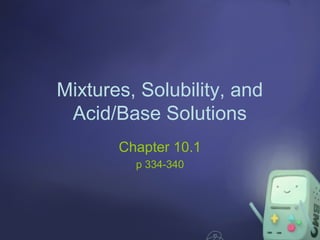Chapter 10.1: Mixtures, Solubility, & Acid/Base Solutions
•Télécharger en tant que PPT, PDF•
6 j'aime•2,802 vues
Grade 8 Integrated Science Chapter 10 Lesson 1 on mixtures, solubility, and acid/base solutions. Understanding concentration, solubility, and what affects both.
Signaler
Partager
Signaler
Partager

Recommandé
Recommandé
Contenu connexe
Tendances
Tendances (20)
En vedette
En vedette (19)
Importance of partition coefficient, solubility and dissociation on pre-formu...

Importance of partition coefficient, solubility and dissociation on pre-formu...
Detailed Lesson Plan (ENGLISH, MATH, SCIENCE, FILIPINO)

Detailed Lesson Plan (ENGLISH, MATH, SCIENCE, FILIPINO)
Similaire à Chapter 10.1: Mixtures, Solubility, & Acid/Base Solutions
Similaire à Chapter 10.1: Mixtures, Solubility, & Acid/Base Solutions (20)
Plus de Korrnell Academy: L Class Grade 8 Science
Plus de Korrnell Academy: L Class Grade 8 Science (20)
Dernier
APM Welcome
Tuesday 30 April 2024
APM North West Network Conference, Synergies Across Sectors
Presented by:
Professor Adam Boddison OBE, Chief Executive Officer, APM
Conference overview:
https://www.apm.org.uk/community/apm-north-west-branch-conference/
Content description:
APM welcome from CEO
The main conference objective was to promote the Project Management profession with interaction between project practitioners, APM Corporate members, current project management students, academia and all who have an interest in projects.APM Welcome, APM North West Network Conference, Synergies Across Sectors

APM Welcome, APM North West Network Conference, Synergies Across SectorsAssociation for Project Management
Mehran University Newsletter is a Quarterly Publication from Public Relations OfficeMehran University Newsletter Vol-X, Issue-I, 2024

Mehran University Newsletter Vol-X, Issue-I, 2024Mehran University of Engineering & Technology, Jamshoro
Dernier (20)
Beyond the EU: DORA and NIS 2 Directive's Global Impact

Beyond the EU: DORA and NIS 2 Directive's Global Impact
ICT Role in 21st Century Education & its Challenges.pptx

ICT Role in 21st Century Education & its Challenges.pptx
Presentation by Andreas Schleicher Tackling the School Absenteeism Crisis 30 ...

Presentation by Andreas Schleicher Tackling the School Absenteeism Crisis 30 ...
APM Welcome, APM North West Network Conference, Synergies Across Sectors

APM Welcome, APM North West Network Conference, Synergies Across Sectors
Measures of Central Tendency: Mean, Median and Mode

Measures of Central Tendency: Mean, Median and Mode
Basic Civil Engineering first year Notes- Chapter 4 Building.pptx

Basic Civil Engineering first year Notes- Chapter 4 Building.pptx
Mixin Classes in Odoo 17 How to Extend Models Using Mixin Classes

Mixin Classes in Odoo 17 How to Extend Models Using Mixin Classes
Z Score,T Score, Percential Rank and Box Plot Graph

Z Score,T Score, Percential Rank and Box Plot Graph
Seal of Good Local Governance (SGLG) 2024Final.pptx

Seal of Good Local Governance (SGLG) 2024Final.pptx
Chapter 10.1: Mixtures, Solubility, & Acid/Base Solutions
- 1. Mixtures, Solubility, and Acid/Base Solutions Chapter 10.1 p 334-340
- 2. Substances • A substance is matter that is always made up of the same combination of atom. • There are 2 types of substances – Elements* • *Only made up of one atom – Compounds • A compound is matter made of atoms of 2 or more elements chemically bonded together • Because the composition of elements and compounds do not change, all elements and compounds are substances
- 3. Mixture • A mixture is two or more substances that are physically blended but are not chemically bonded together. – *The amount of each substance in a mixture can vary. (Unlike atoms in a compound)
- 4. Mixtures • Granite – A type of rock – Composition of different rocks • Air – Doesn’t look like a mixture – 78% nitrogen – 21% oxygen – 1% other substances
- 7. 2 Types of Mixtures • Heterogeneous Mixture – Heterogeneous = diverse • Homogeneous Mixture – Solutions – Homogeneous = of the same kind; alike
- 8. Heterogeneous Mixture • A heterogeneous mixture is a mixture in which substances are not even mixed. – Example: • Granite is a heterogeneous mixture. It is not evenly mixed. • Often, you can see the different substances and parts of a heterogeneous mixture with unaided eyes, but sometimes you need a microscope. – Example: • Blood is a heterogeneous mixture. • It looks evenly mixed, but with a microscope you can easily see areas with more of one component and less of another. • Heterogeneous mixture can be hard to tell.
- 10. Which of the following diagrams shows a heterogeneous mixture?
- 11. Solution – Homogeneous Mixtures • Many mixtures look evenly mixed even when you view them with a powerful microscope. • These mixtures are homogeneous • A homogeneous mixture is a mixture in which two or more substances are evenly mixed on the atomic level but not bonded together. – The mixture looks evenly mixed because the individual atoms and compounds are too small to see
- 13. Solution • *Another name for a homogeneous mixture is a solution. • Air is a solution. Soda is also a solution. • Heterogeneous mixture can be hard to tell.
- 15. How do compounds and mixtures differ? • There are 2 important differences between compounds and mixtures – Substances in a mixture keep their properties because they are not chemically changed • Salt water is a mixture. You can’t see the salt, but you can taste it in the water. • In contrast, sodium and chlorine bond to form table salt. – Sodium is a soft, opaque, silvery metal – Chlorine is a greenish, poisonous gas – Salt has none of these properties
- 16. – Mixtures can be separated • Because substances in mixtures are not bonded, they can be separated using physical methods – For example you can boil the water out of salt water – The physical properties of one substance will differ from the other, so they can be physically separated • In contrast, compounds can only be separated by chemical change that breaks the bonds between the elements. – Look at the figure on page 339
- 17. Distillation of Salt Water
